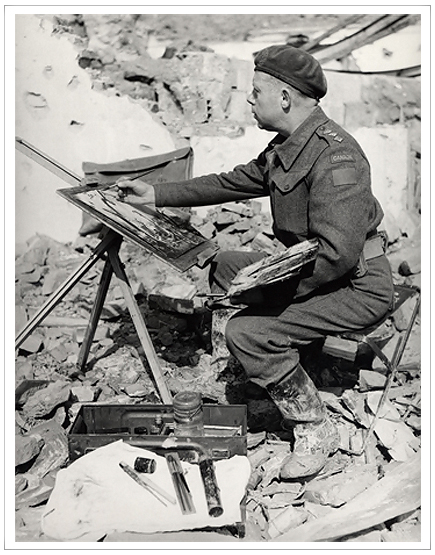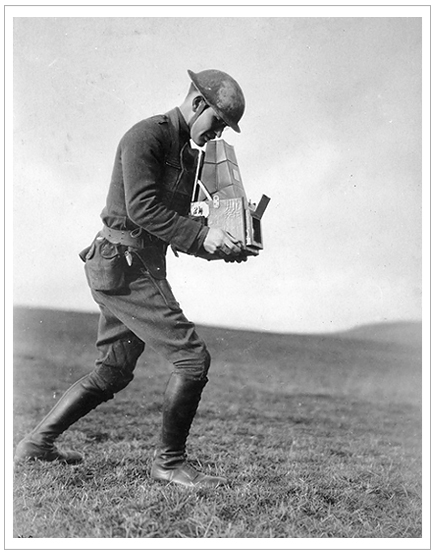diptych # 73 ~ the art of war / what the camera cannot interpret
 Tuesday, July 22, 2014 at 11:42AM
Tuesday, July 22, 2014 at 11:42AM 
Canadian War Museum ~ Ottawa, CA • click to embiggen WWI war painter
WWI war painter
war paintings / Canadian War Museum Collection ~ Ottawa, CA • click to embiggen WWI war photographer
WWI war photographer
war photographs • click to embiggenLast week on a rainy day, while in the Rideau Lakes Region, the wife and I took Hugo (his 2nd visit) and his friend to the Canadian War Museum in Ottawa. If ever there was a place for 2 nine year olds to be on a rainy day, the CNWM is it.
I was quite impressed by the few war paintings on exhibit in the museum. Little did I know, until I reached the museum gift shop, that the handful of paintings I viewed were barely a drop in the bucket from the 13,000+ war paintings in the museum's collection. It was in the gift shop that I came across (and purchased) a book, Canvas of War, an overview of the museum's collection, albeit a 110 painting drop in the bucket. And, the artwork depicted therein, is, in a word, amazing - a diverse range of painting styles / genres and mediums.
That written, what surprised, amazed, and somewhat befuddled me was the fact that the genesis of the collection stems from two Canadian enterprises - in WWI, the Canadian War Memorial Fund and, in WWII, the Canadian War Records program - which commissioned (CWMF) and hired (CWR) artists to record Canada's wartime contribution on land, at sea, in the air, and on the homefront in paintings. Artists who were sent to the battle front / theaters of war in order to create from firsthand personal experience, as opposed to from combatant's memories and recounting, images of war.
Now, for all I know, those enterprises may have also commissioned / hired photographers to accomplish the same ends, But I think not, given that the aim of the enterprises was stated as to create what "the camera cannot interpret."
It would be easy for me to go all postal, verbal wise, over the camera cannot interpret thing but, in fact, that notion was part and parcel of the then prevailing wisdom of the art world - the camera records, the brush interprets / painters are artists, photographers are cameramen. So, it would be foolish to go off halfcocked over a previous art generation's failure to understand and appreciate the camera's ability to interpret.
In any event, I questioned whether the medium of photography had the means, hardware wise, to produce "quality" pictures in and of a wartime environment, WWI specifically. So, I did a little research and come to learn, my misgivings were totally misplaced. Not only are there thousands of high quality photographs from that war, but included amongst them are hundreds of color photographs as well.
Holy Autochrome Lumiere, Batman. Who would have thought?
All of the preceding written, I am left with the thoughts of paintings v. photographs. Thoughts somewhat along the lines of that expressed by the fictional character of the young photographer, Holgrave, in Hawthorne's The House of Seven Gables. To wit, his remark about a daguerreotype picture:
... while we give it credit only for depicting the merest surface, it actually brings out the secret character with a truth that no painter would ever venture upon, even could he detect it.
So I wonder. Are the war painting too decorative? In a sense, too interpretive for their own good, re: the telling of the "true" story of the horrors of wars? Are the war photographs too realistic to ever serve as decoration? In a sense, too true for their own good, re: to difficult to bear in the interest of being considered as art? Do the paintings, with their resolute beauty as objects, "sugar-coat" the reality of war? Are the photographs mere "documents" which cooly record that same reality?
And, is the painting of the marching soldiers any more (or less) emotionally charged / convincing than is the photograph of the 3 soldiers taking a break on the battlefield? What about the painting of the relaxing airmen versus the photograph of the raucous soldiers? Is the notion of camaraderie stronger in one over the other? Is the detailed specificity of photography more or less emotionally powerful than the somewhat abstract universality of painting?
The only thing I am certain of, re: the preceding questions, is that I would dearly love to view an exhibit which feature the best of both worlds. Now that would both interesting and engaging - visually, emotionally, and intellectually.
BTW, opinions on / answers to the the previous questioned are encouraged.


Reader Comments (1)
Hello. So happy to see that you enjoyed your recent visit to the Canadian War Museum. I wanted to point out that one of our two current special exhibitions is focused on landscape art in wartime through the eyes of two artists: Canadian A.Y. Jackson and German Otto Dix. Not sure if you had a chance to visit the Transformations exhibit, but there is also a great campanion publication.